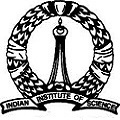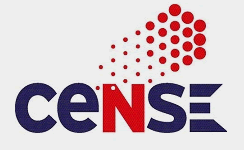Powder/thinfilm XRD
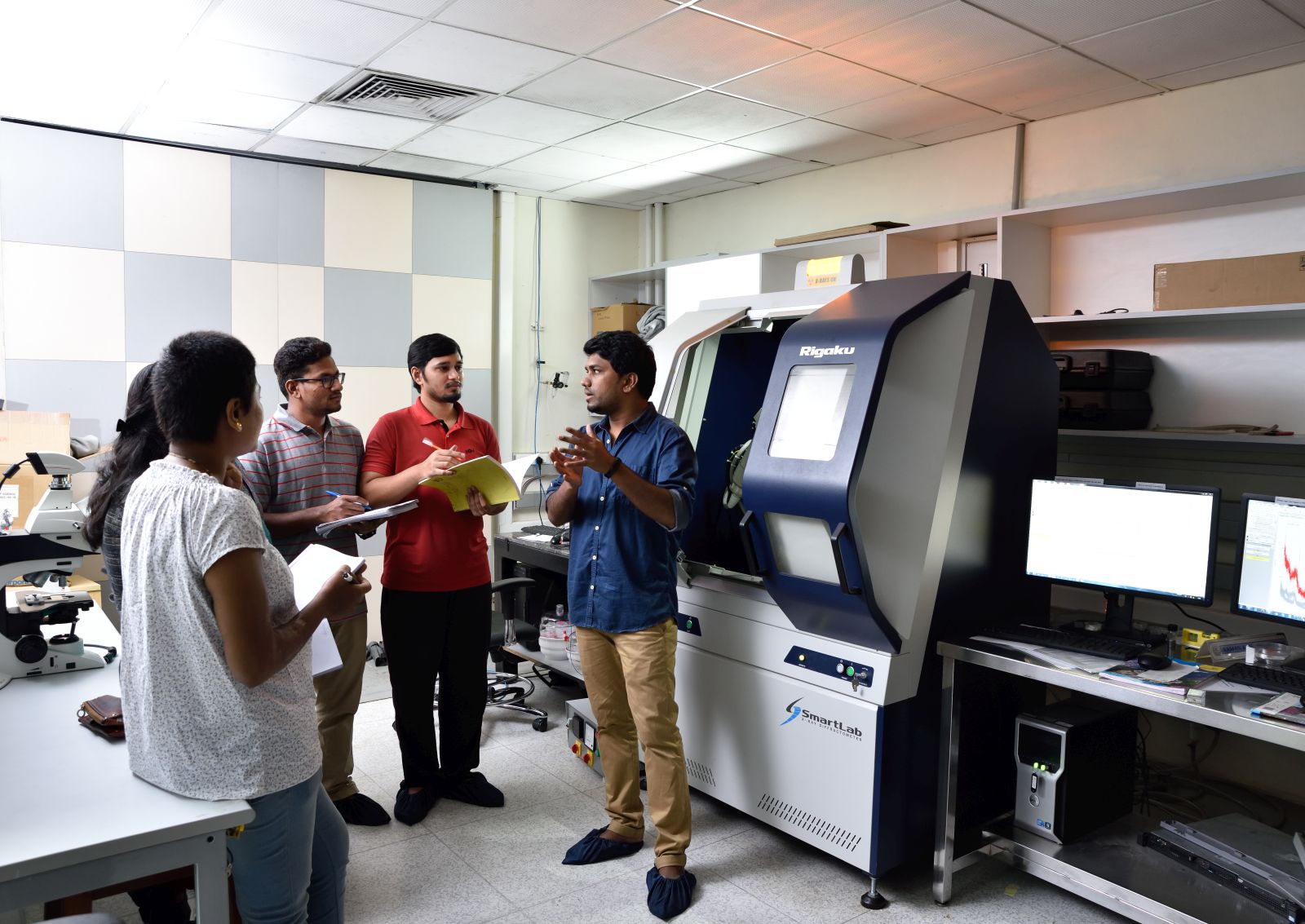
The Rigaku SmartLab is a highly flexible general purpose X-ray diffractometer system. It includes optics for both standard Bragg-Brentano (BB) and parallel-beam (PB) optics for use with poly crystalline thin films/powders and nano-materials.This also include a Scintillation counter (SC) and speed 1D(line) detector (Dtex).
Measurement Capabilities:-
- Phase identification of the materials.
- Crystallize Size of the materials.
- Chemical composition of the materials.
Four circle XRD (HR XRD)
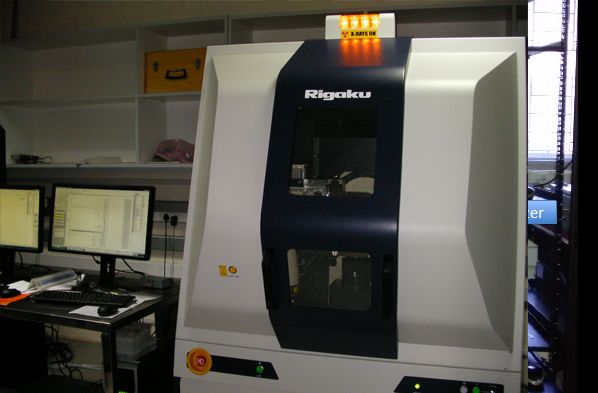
The Rigaku SmartLab is a highly flexible general purpose High Resolution X-ray diffractometer system. It includes optics for both High resolution and Ultra high resolution for oriented thinfilm/bulk samples.This also include a Scintillation counter (SC) and a high-speed 2D(area) detector (Pilatus).
Measurement Capabilities:
- Pole Figure measurement for textured samples(to study the orientation of the sample ).
- Rocking Curve.
- Reciprocal space measurement for epitaxial samples.
- Residual stress measurement.
- X-ray reflectivity for thinfilms(to determine the thickness, density,and interface/surface roughness of the sample) .
- X-ray mapping.
Raman and MicroPL System

Fast, non-destructive chemical analysis of solids, powders, liquids, and gases The LabRAM HR (UV) system is a state of the art RAMAN/PL. This spectroscopic system provides high spectroscopic resolution and a unique wavelength range capability that offers both great flexibility and high performance. LabRAM HR allows the collection of large area Raman images, using the X,Y and Z mapping features, in seconds/minutes. UV, Visible Raman with 325nm and 514nm LASER using CCD detector.
General Features:-
- Raman and Photoluminescence spectroscopy, Resonance Raman, Surface enhanced Raman, Raman mapping (material, phase, strain etc), photoluminescence (PL) mapping, IR-PL
- Characterisation of carbon materials,strain measurements & Raman/PL imaging
- Determination of composition and phase,Band gap determination,Material Quality,Impurity levels and defect detection
UV-VIS-NIR Spectrometer

The Shimadzu MPC3600 a state of the art UV-VIS-NIR Spectrometer. This spectroscopic system provides high spectroscopic resolution and a unique wavelength range capability that offers both great flexibility and high performance. MPC3600 is equipped with integrating sphere for the measurement of transmission of solid samples.
Measurement Capabilities:-
- Absorption, transmission studies for liquid and thin films. It can cover broad wavelength range including UV to NIR region (200nm to 3200nm).
- Absolute Specular Reflectance and Diffuse Reflectance studies from UV to NIR region (250nm to 2500nm).
- We can also study transmission for solid samples using integrating sphere.
- Instrument has the capability to perform kinetic studies with the instrument.
Zeta Phase Analysis Light Scattering (Zeta PALS)
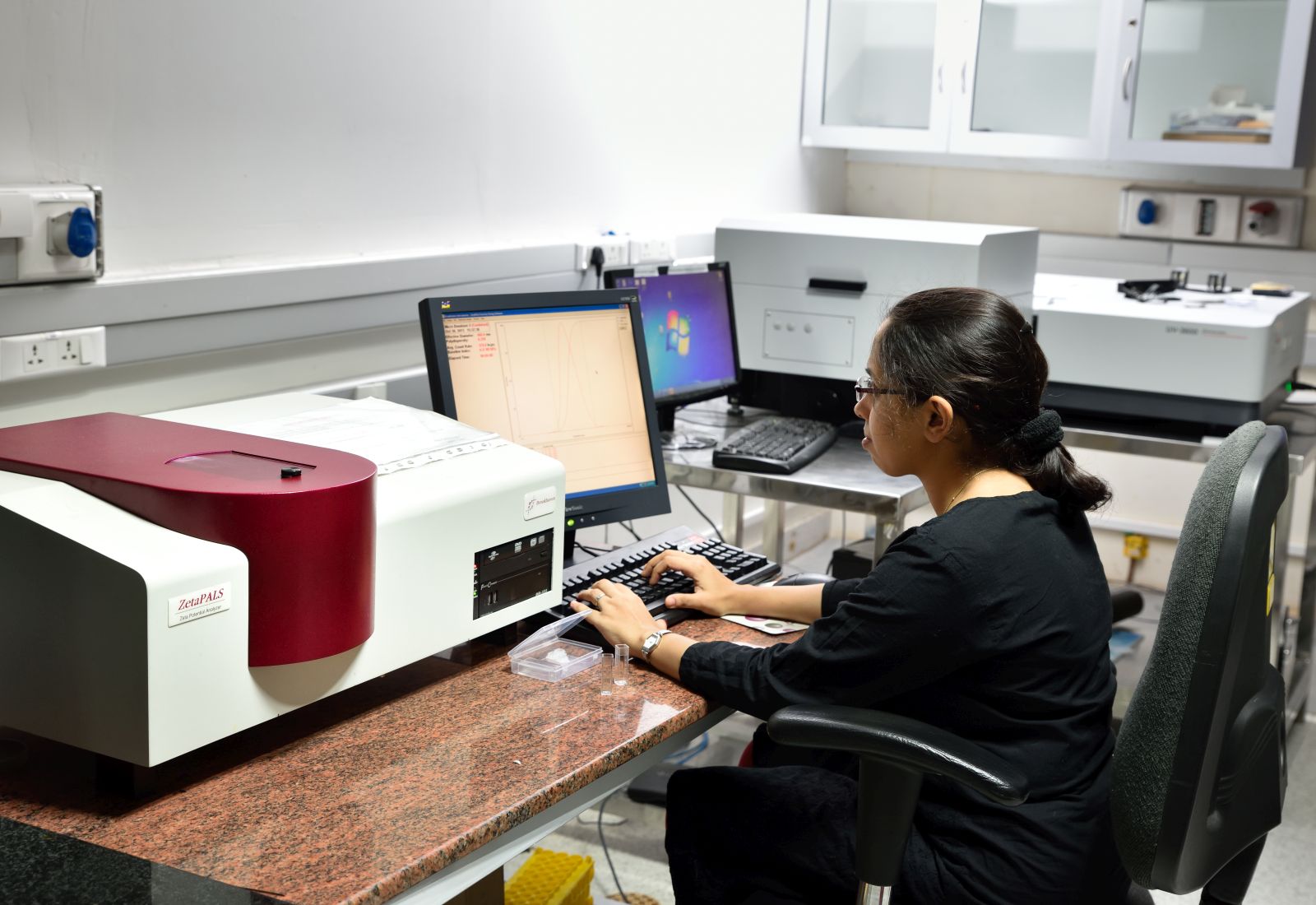
The Zeta PALS determines zeta potential using Phase Analysis Light Scattering: A technique that is up to 1,000 times more sensitive than traditional light scattering methods based on the shifted frequency spectrum. Electrostatic repulsion of colloidal particles is often the key to understanding the stability of any dispersion. A simple, easy measurement of the electrophoretic mobility “even in nonpolar liquids” yields valuable information. Measurements made in water and other polar liquids are easy and fast with the ZetaPlus. Such measurements cover the range of typically 9 – 100 mV, corresponding to a range of mobilities of 0.5-8 x 10-8 m²/V s
Zeta Potential Specifications:
- Size Range: 1 nm to 100 μm
- Mobility Range: 10⁻11 to 10⁻7 m²/V · s
- Zeta potential range : -220 mV to 220 mV
- Maximum Sample Concentration : 10% v/v
- Sample Volume : 180 μL, 600 μL, 1,250 μL
- Maximum sample conductivity: 30 S/m
- Signal Processing: Phase Analysis Light Scattering, PALS
- Size Range : 3nm to 3μm
- Sample Volume: 10 μL, 40 μL, 1 – 3 mL
- Concentration Range: 0.1 mg/mL to 10% v/v
Particle Sizing:-
An optional feature of the ZetaPALS is the measurement of particle size by dynamic light scattering. Based on the established techniques, particle size and distribution information are obtained in minutes. Particle size measurements and zeta potential determination are made in the same cell. There is a choice of two scattering angles, 15° or 90°, for particle sizing.
Particle Sizing Specifications:-
Size Range : 3nm to 3μm Sample Volume: 10 μL, 40 μL, 1 – 3 mL Concentration Range: 0.1 mg/mL to 10% v/v
Fourier Transform infrared spectroscopy (FTIR)
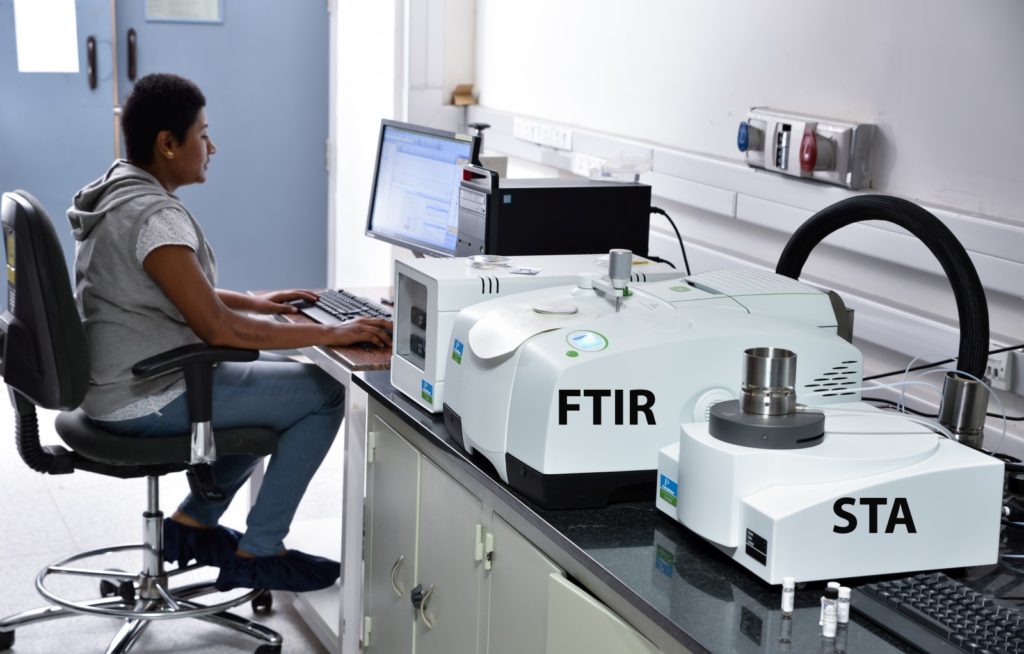
Fourier Transform infrared spectroscopy (FTIR) is a technique which is used to obtain an infrared spectrum of absorption or emission of a solid, liquid or gas. An FTIR spectrometer simultaneously collects high spectral resolution data over a wide spectral range.
FTIR Specifications:
- Mid-IR (KBr) beamsplitter spectral range: 7800-350 cm-1
- Spectral resolution: 0.5-64 cm-1
- Wavelength Repeatability: ±0.02 cm at 1,600 cm
- Wavelength accuracy: ±0.1 cm at 1,600 cm
- Detectors: TGS and Liquid nitrogen cooled MCT
Universal Attenuated Total Reflectance (UATR)
- Operational range: 7800-650 cm-1
- Powder, Liquid and smooth films can be studied.
Diffusive reflection
- Operational range: 7800-400 cm-1
- Powder, coating etc can be studied
Specular reflectance
- Operational range: 7800-400 cm-1
- Thin films, thick films, films over metallic substrates etc can be studied
Transmittance
- Operational range: 7800-400 cm-1
- KBr pellet method as well as direct transmission studies
- Liquid cell and gas cell for respective sample states
TG-IR
- Hyphenation of TGA available for evolved gas analysis
- Heating range room temperature to 1500 degree Celsius
- Heating rate 1-100 degree per minute, depends on the heating range
Simultaneous Thermal Analyser 8000 (STA 8000)
STA measures both heat flow (Differential Scanning Calorimeter) and weight changes (Thermal Gravimetric Analysis) in a material as a function of temperature or time in a controlled atmosphere. Typical sample requirement is 10-20 mg. Samples are heated in open alumina crucibles where TGA, DTA and DSC data are acquired. Since this is not a dedicated DSC instrument, heat flow data will look broader. User must send MSDS of the sample, while requesting for sample analysis.
General Features:-
- Simultaneous analysis of TG with DTA mode.
- Wide temperature ranges from 15 °C temperature to 1000 °C.
- Heating rate 1 degree per minute to 100 1degree per minute..
- Nitrogen inert gas environment
- Superior weight, heat flow and temperature accuracy
- Top loading balance
- Balance below furnace for optimum isolation from contamination
- Vertical displacement balance sensor (not rotational) provides weight insensitivity to sample position
Sol3A Class AAA Solar Simulator
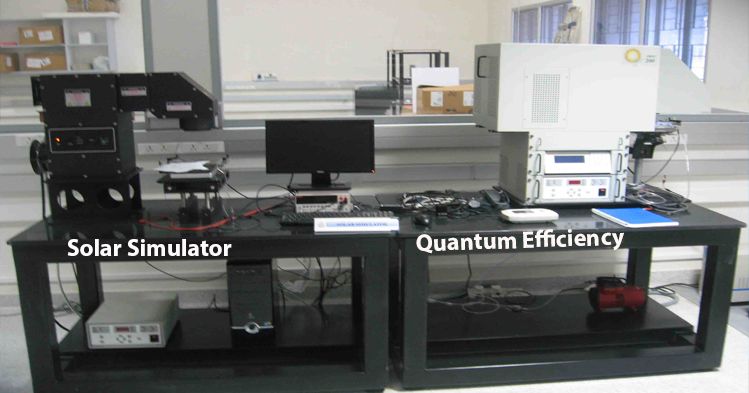
Solves all your solar cell characterization requirements!.
General Features:-
- Output beam sizes 2×2”, 4×4”, 6×6” , 8×8”, and 12 x 12”
- Calibration certificate validating Class AAA performance for all 3 standards: IEC, ASTM and JIS Long-lived, highly reliable instruments designed specifically for • 24/7 production environments
- Non-reflective black finish reduces stray light
- Temperature sensors and interlocks ensure operator safety
- Improved optical design for maximum spatial uniformity
- Improved working distances accommodate larger samples
- Sun light exposure testing and material stability studies for textile, plastics and paints
Newport Oriel – Internal Quantum Efficiency 200
Oriel IQE-200 Series Systems are quantum efficiency measurement instruments used to measure the External Quantum Efficiency (EQE) and Internal Quantum Efficiency (IQE) of solar cells,detectors, or other photovoltaic devices. Devices which need bottom illumination should fabricate contact compatible with crocodile clips.
General Features:-
- Wavelength Range: 350nm – 1100nm
- Wavelength accuracy is 0.5 nm
- Repeatability is +/-0.2% from 400 – 1000 nm
- Spectral resolution: 10 nm
- Spot size: 1*2.5 mm
- QTH lamp
- Sample Size: 2 x 2 to 6 x 6 inch
Leica DM2500
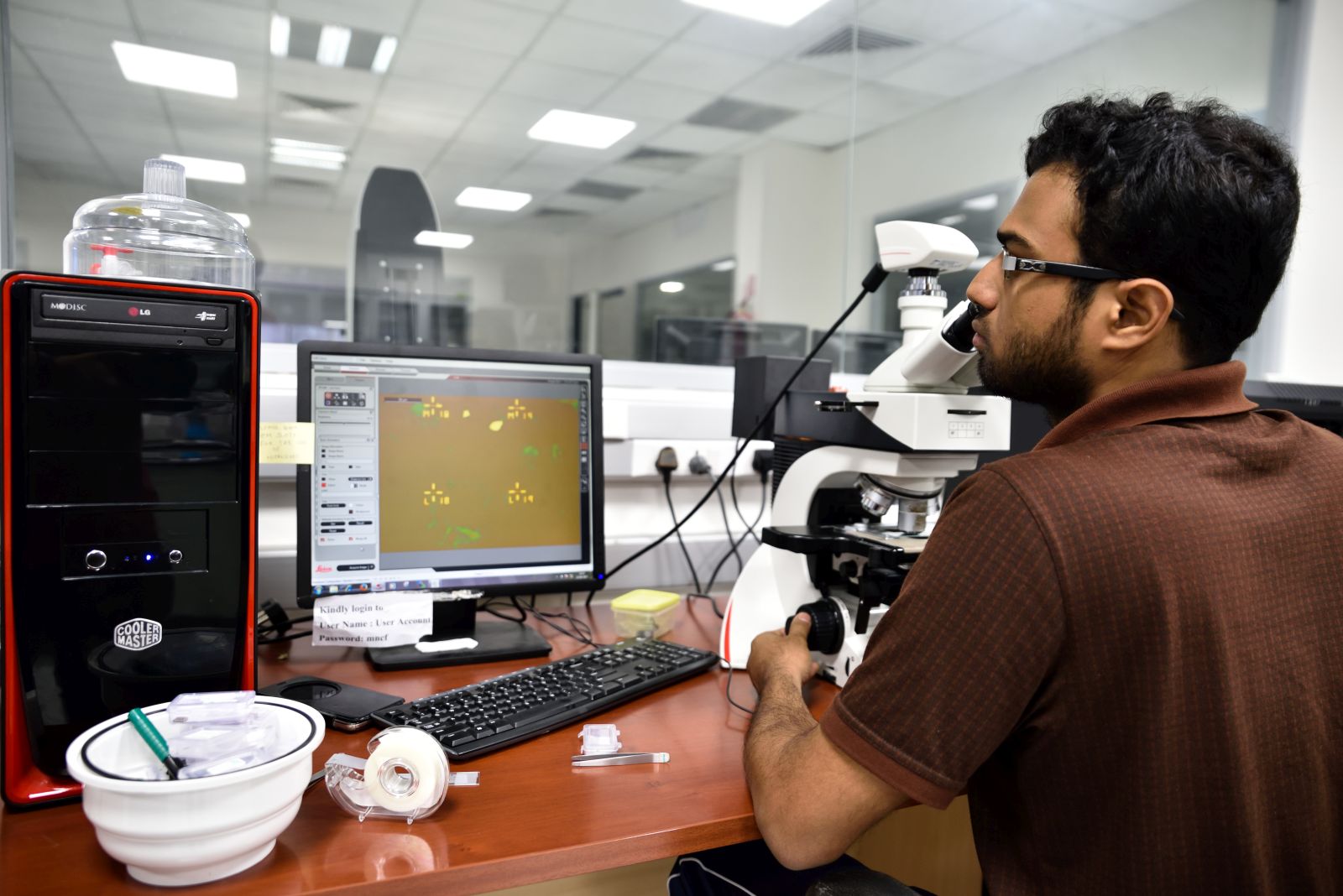
Differential interference contrast and high-performance fluorescence capability of the microscope can be used to study various properties of the sample.
General Features:-
- Objectives 2.5X, 10X, 20X, 40X, 100X
- Oil immersion capability
- Filters: red, green and blue
- Binocular
- Digital camera (DFC 450C)
- Image resolution : 5 megapixels
- Bright field, Dark field and fluorescence applications
Leica DM 2500 Fluorescence Microscope
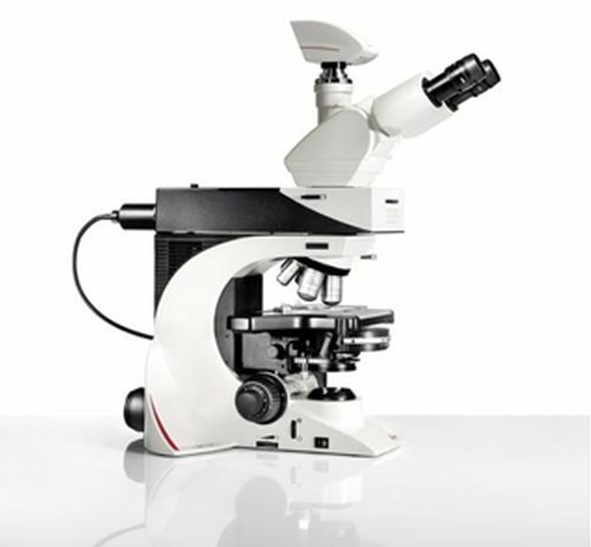
General Use : It is used to visually enhance specific features at small scales for example microbes by attaching fluorescent tags to anti-bodies that in turn attach to targeted features
Specifications:
- Camera imaging system-Leica DFC450 C camera with C Mount 0.55X.
- Fluorescence illumination system- Fluorescent Filters sets : red, green and blue (A, I3, N2.1)
- Plan achromats N PLAN 5x, 10x, 20x, 40x, 100x, pair of eyepieces 10x/22M

